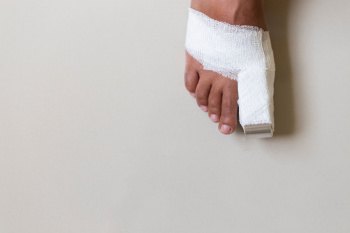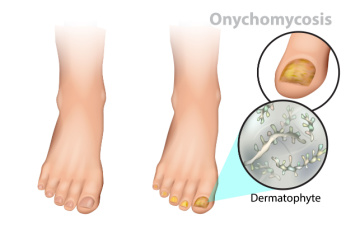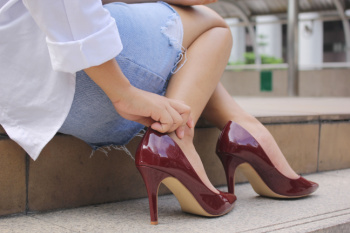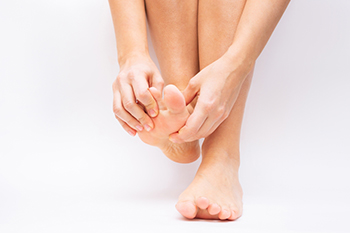February 2025
Gout Pain Can Be Managed
Managing a Broken Toe

A broken toe often occurs from stubbing the toe, dropping something heavy on it, or during sports activities. It typically affects the small toe but can occur in any of the toes. Symptoms include pain, swelling, bruising, and difficulty walking. The toe may also appear crooked or misaligned, especially in more severe fractures. Treating a broken toe often involves buddy taping, where the injured toe is taped to the neighboring toe for support. In less severe cases, this method can stabilize the toe and allow it to heal. For more serious fractures, a podiatrist may recommend a splint, or, in rare cases, surgery to realign the bones. This type of doctor can assess the extent of the injury, provide pain management, and guide you through the recovery process. They will also monitor for complications, such as infection or improper healing. If you think you have broken a toe, it is suggested that you promptly schedule an appointment with a podiatrist for a proper diagnosis and appropriate treatment.
Broken toes may cause a lot of pain and should be treated as soon as possible. If you have any concerns about your feet, contact one of our podiatrists from Bazzi Podiatry. Our doctors will treat your foot and ankle needs.
What Is a Broken Toe?
A broken toe occurs when one or more of the toe bones of the foot are broken after an injury. Injuries such as stubbing your toe or dropping a heavy object on it may cause a toe fracture.
Symptoms of a Broken Toe
- Swelling
- Pain (with/without wearing shoes)
- Stiffness
- Nail Injury
Although the injured toe should be monitored daily, it is especially important to have a podiatrist look at your toe if you have severe symptoms. Some of these symptoms include worsening or new pain that is not relieved with medication, sores, redness, or open wounds near the toe.
If you have any questions, please feel free to contact one of our offices located in Detroit, West Detroit, Northwest Detroit, Sterling Heights, Hamtramck, Dearborn Heights, Madison Heights, Redford, and Livonia, MI . We offer the newest diagnostic and treatment technologies for all your foot care needs.
Signs of Improved Toenail Fungus

Toenail fungus can be a persistent and frustrating condition, but several signs indicate improvement after treatment. The color of the affected nail typically lightens, with less yellowing or discoloration as the nail begins to grow healthier. The thickness of the nail may also reduce, and the texture becomes smoother. As healing progresses, the area surrounding the nail becomes less inflamed or irritated, showing signs of recovery. Prescribed medications are often the first line of defense in treating toenail fungus. Podiatrists may recommend antifungal oral medications or topical treatments to combat the infection. For those who do not respond to medication, laser treatment has emerged as a promising alternative. Laser therapy targets the fungus directly, penetrating the nail to eliminate the infection. Toenail fungus can be unsightly, causing embarrassment. If you see signs of a toenail fungus. It is suggested that you promptly contact a podiatrist who can effectively treat this condition.
If left untreated, toenail fungus may spread to other toenails, skin, or even fingernails. If you suspect you have toenail fungus it is important to seek treatment right away. For more information about treatment, contact one of our podiatrists of Bazzi Podiatry. Our doctors can provide the care you need to keep you pain-free and on your feet.
Symptoms
- Warped or oddly shaped nails
- Yellowish nails
- Loose/separated nail
- Buildup of bits and pieces of nail fragments under the nail
- Brittle, broken, thickened nail
Treatment
If self-care strategies and over-the-counter medications does not help your fungus, your podiatrist may give you a prescription drug instead. Even if you find relief from your toenail fungus symptoms, you may experience a repeat infection in the future.
Prevention
In order to prevent getting toenail fungus in the future, you should always make sure to wash your feet with soap and water. After washing, it is important to dry your feet thoroughly especially in between the toes. When trimming your toenails, be sure to trim straight across instead of in a rounded shape. It is crucial not to cover up discolored nails with nail polish because that will prevent your nail from being able to “breathe”.
In some cases, surgical procedure may be needed to remove the toenail fungus. Consult with your podiatrist about the best treatment options for your case of toenail fungus.
If you have any questions, please feel free to contact one of our offices located in Detroit, West Detroit, Northwest Detroit, Sterling Heights, Hamtramck, Dearborn Heights, Madison Heights, Redford, and Livonia, MI . We offer the newest diagnostic and treatment technologies for all your foot care needs.
How Wearing High Heels Can Impact on Feet

Wearing high heels regularly can have significant effects on the feet, leading to a range of discomforts and long-term foot conditions. High heels alter the natural alignment of the foot, shifting body weight forward onto the toes and putting excessive pressure on the forefoot. This can result in pain, inflammation, and instability in the feet. Prolonged use of high heels may contribute to conditions such as bunions, hammertoes, and plantar fasciitis. Bunions develop when the big toe joint becomes misaligned, while hammertoes occur when the toes are forced into an unnatural position. The pressure from high heels can also cause the thickening of the tissue on the bottom of the foot, leading to the formation of calluses or corns. Over time, wearing high heels can strain the Achilles tendon, resulting in discomfort or limited range of motion. If you often wear high heels and have developed foot pain, it is suggested that you contact a podiatrist who can offer effective relief tips, and guide you on appropriate shoes to wear.
High heels have a history of causing foot and ankle problems. If you have any concerns about your feet or ankles, contact one of our podiatrists from Bazzi Podiatry. Our doctors can provide the care you need to keep you pain-free and on your feet.
Effects of High Heels on the Feet
High heels are popular shoes among women because of their many styles and societal appeal. Despite this, high heels can still cause many health problems if worn too frequently.
Which Parts of My Body Will Be Affected by High Heels?
- Ankle Joints
- Achilles Tendon – May shorten and stiffen with prolonged wear
- Balls of the Feet
- Knees – Heels cause the knees to bend constantly, creating stress on them
- Back – They decrease the spine’s ability to absorb shock, which may lead to back pain. The vertebrae of the lower back may compress.
What Kinds of Foot Problems Can Develop from Wearing High Heels?
- Corns
- Calluses
- Hammertoe
- Bunions
- Morton’s Neuroma
- Plantar Fasciitis
How Can I Still Wear High Heels and Maintain Foot Health?
If you want to wear high heeled shoes, make sure that you are not wearing them every day, as this will help prevent long term physical problems. Try wearing thicker heels as opposed to stilettos to distribute weight more evenly across the feet. Always make sure you are wearing the proper shoes for the right occasion, such as sneakers for exercising. If you walk to work, try carrying your heels with you and changing into them once you arrive at work. Adding inserts to your heels can help cushion your feet and absorb shock. Full foot inserts or metatarsal pads are available.
If you have any questions please feel free to contact one of our offices located in Detroit, West Detroit, Northwest Detroit, Sterling Heights, Hamtramck, Dearborn Heights, Madison Heights, Redford, and Livonia, MI . We offer the newest diagnostic and treatment technologies for all your foot and ankle needs.
Causes and Relief for Stubbed Toe Pain

Stubbed toe pain occurs when the toe strikes a hard surface, often leading to sudden discomfort and swelling. This type of injury usually happens when a person accidentally bumps their toe against furniture, door frames, or other obstacles. The force of impact can cause bruising, tenderness, or even a mild fracture. The most affected area is typically the big toe, though other toes can also be injured. Relief from stubbed toe pain can be found by resting the foot and elevating it to reduce swelling. It is also advisable to avoid putting pressure on the toe by wearing comfortable, stiff-soled shoes. If the pain persists or if there is significant swelling or deformity, it is suggested that you seek medical attention from a podiatrist who can offer you additional effective relief tips.
Toe pain can disrupt your daily activities. If you have any concerns, contact one of our podiatrists of Bazzi Podiatry. Our doctors can provide the care you need to keep you pain-free and on your feet.
What Causes Toe Pain?
Most severe toe pain is caused due to a sports injury, trauma from dropping something heavy on the toe, or bumping into something rigid. Other problems can develop over time for various reasons.
Toe pain can be caused by one or more ailments. The most common include:
- Trauma
- Sports injury
- Wearing shoes that are too tight
- Arthritis
- Gout
- Corns and calluses
- Hammertoe
- Bunions
- Blisters
- Ingrown toenails
- Sprains
- Fractures (broken bones)
- Dislocations
When to See a Podiatrist
- Severe pain
- Persistent pain that lasts more than a week
- Signs of infection
- Continued swelling
- Pain that prevents walking
Diagnosis
In many cases the cause of toe pain is obvious, but in others, a podiatrist may want to use more advanced methods to determine the problem. These can range from simple visual inspections and sensation tests to X-rays and MRI scans. Prior medical history, family medical history, and any recent physical traumatic events will all be taken into consideration for a proper diagnosis.
Treatment
Treatments for toe pain and injuries vary and may include shoe inserts, padding, taping, medicines, injections, and in some cases, surgery. If you believe that you have broken a toe, please see a podiatrist as soon as possible.
If you have any questions please feel free to contact one of our offices located in Detroit, West Detroit, Northwest Detroit, Sterling Heights, Hamtramck, Dearborn Heights, Madison Heights, Redford, and Livonia, MI . We offer the newest diagnostic tools and technology to treat your foot and ankle needs.





